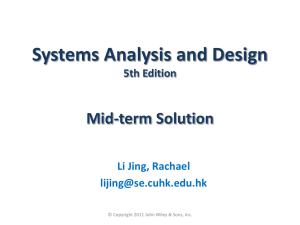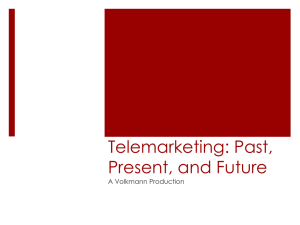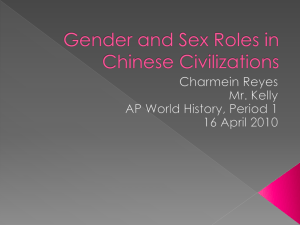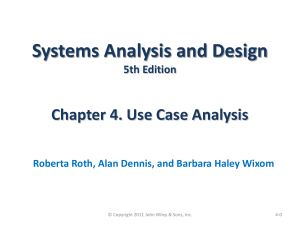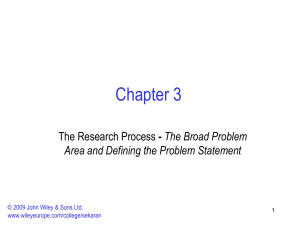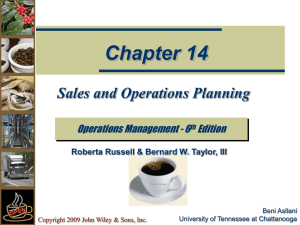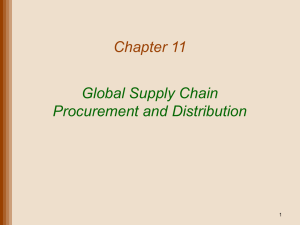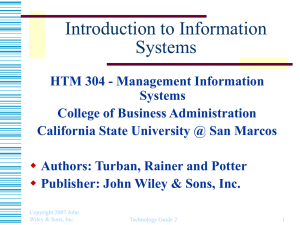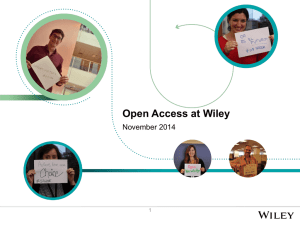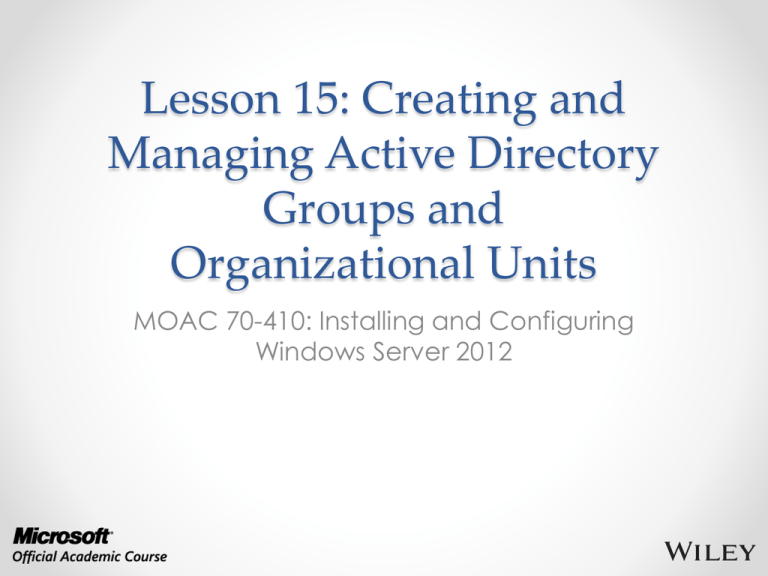
Lesson 15: Creating and
Managing Active Directory
Groups and
Organizational Units
MOAC 70-410: Installing and Configuring
Windows Server 2012
Overview
• Exam Objective 5.3: Create and Manage
Active Directory Groups and Organizational
Units (OUs)
• Designing an Internal Domain Structure
• Working with Organizational Units
• Working with Groups
© 2013 John Wiley & Sons, Inc.
2
Designing an Internal
Domain Structure
Lesson 15: Creating and Managing Active
Directory Groups and Organizational Units
© 2013 John Wiley & Sons, Inc.
3
Designing an Internal
Domain Structure
• Within a domain, the primary hierarchical
building block is the organizational unit (OU).
• It is easier to build an Active Directory hierarchy
using OUs than it is using domains.
• It is a simple matter to create new OUs, rename
existing ones, and move them around.
• Creating a new domain means deploying
additional domain controllers, and while it is
possible to rename a domain, it is not a simple
process.
© 2013 John Wiley & Sons, Inc.
4
Inheritance
• When you assign Group Policy settings to a
domain, the settings apply to all of the
objects in that domain, but not to the
subdomains.
• when you assign Group Policy settings to an
OU, those settings apply to all of the leaf
objects in the OU and are inherited by any
subordinate OUs it contains.
© 2013 John Wiley & Sons, Inc.
5
Inheritance
Group Policy inheritance within a domain
© 2013 John Wiley & Sons, Inc.
6
Using Organizational
Units
Reasons for creating an OU:
• Duplicating organizational divisions: The structure of OUs
within your domains should be an extension of the model
you used to design the Active Directory domain
structure:
o Geographical
o Departmental
o Political
• Assigning Group Policy settings: To assign different
Group Policy settings to a particular collection of
objects.
• Delegating administration: To grant certain individuals
administrative responsibility for a portion of the Active
Directory hierarchy, without giving them full access to
the entire domain.
© 2013 John Wiley & Sons, Inc.
7
Using Group Objects
• Create a group when you want to grant a
collection of users permission to access a
network resource, such as a file system share
or a printer.
• Groups are not part of the AD hierarchy.
• members of a group inherit any permissions
that you assign to the group, but they do
not inherit the Group Policy settings from the
group’s parent OUs and domain.
© 2013 John Wiley & Sons, Inc.
8
Working with
Organizational Units
Lesson 15: Creating and Managing Active
Directory Groups and Organizational Units
© 2013 John Wiley & Sons, Inc.
9
Working with
Organizational Units
• OUs can be nested to create a design that
enables administrators to take advantage
of inheritance.
• Limit the number of OUs that are nested,
because too many levels can:
o Slow the response time to resource requests
o Complicate the application of Group Policy
settings
© 2013 John Wiley & Sons, Inc.
10
Working with
Organizational Units
• There is only one built-in OU by default:
the Domain Controllers OU.
• All other OUs must be created by the
domain administrator.
© 2013 John Wiley & Sons, Inc.
11
Containers
Default container objects:
o Users: Contains the domain’s predefined users
and groups.
o Computer: Contains computer objects in the
domain.
You cannot assign Group Policy settings to
computer objects or delegate their
administration.
© 2013 John Wiley & Sons, Inc.
12
Creating OUs
The Create Organizational Unit window in the Active
Directory Administrative Center console
© 2013 John Wiley & Sons, Inc.
13
Creating OUs
The New Object – Organizational Unit dialog box in the
Active Directory Users and Computers console
© 2013 John Wiley & Sons, Inc.
14
Creating OUs
The Move dialog box in the Active Directory
Administrative Center console
© 2013 John Wiley & Sons, Inc.
15
Using OUs to Delegate
AD Management Tasks
• Creating OUs enables you to implement a
decentralized administration model, in which
others manage portions of the AD DS hierarchy,
without affecting the rest of the structure.
• Delegating authority at a site level affects all
domains and users within the site.
• Delegating authority at the domain level
affects the entire domain.
• Delegating authority at the OU level affects
only that OU and its subordinate objects.
© 2013 John Wiley & Sons, Inc.
16
Using OUs to Delegate
AD Management Tasks
By granting administrative authority over an OU
structure, as opposed to an entire domain or
site, you gain the following advantages:
• Minimal number of administrators with global
privileges: By creating a hierarchy of
administrative levels, you limit the number of
people who require global access.
• Limited scope of errors: Administrative mistakes
such as a container deletion or group object
deletion affect only the respective OU structure.
© 2013 John Wiley & Sons, Inc.
17
Delegate Administrative Control
of an OU
The Users or Groups page of the Delegation of
Control Wizard
© 2013 John Wiley & Sons, Inc.
18
Delegate Administrative Control
of an OU
The Tasks to Delegate page of the Delegation of
Control Wizard
© 2013 John Wiley & Sons, Inc.
19
Delegate Administrative Control
of an OU
The Active Directory Object Type page of the
Delegation of Control Wizard
© 2013 John Wiley & Sons, Inc.
20
Delegate Administrative Control
of an OU
The Permissions page of the Delegation of
Control Wizard
© 2013 John Wiley & Sons, Inc.
21
Delegate Administrative Control
of an OU
The Security tab of an organizational unit’s
Properties sheet
© 2013 John Wiley & Sons, Inc.
22
Working with Groups
Lesson 15: Creating and Managing Active
Directory Groups and Organizational Units
© 2013 John Wiley & Sons, Inc.
23
Working with Groups
© 2013 John Wiley & Sons, Inc.
24
Group Types
There are two Windows Server 2012 group
types:
• Distribution groups: Non-security-related
groups created for the distribution of
information to one or more persons.
• Security groups: Security-related groups
created for purposes of granting resource
access permissions to multiple users.
© 2013 John Wiley & Sons, Inc.
25
Group Scopes
• The group scope controls which objects the
group can contain.
• Limits the objects to the same domain or
permits objects from remote domains.
• Controls the location in the domain or forest
where the group can be used.
• Group scopes available in an Active
Directory domain include domain local
groups, global groups, and universal groups.
© 2013 John Wiley & Sons, Inc.
26
Domain Local Groups
Domain local groups can have any of the
following as members:
• User accounts
• Computer accounts
• Global groups from any domain in the forest
• Universal groups
• Domain local groups from the same domain
© 2013 John Wiley & Sons, Inc.
27
Global Groups
Global groups can have the following as
members:
• User accounts
• Computer accounts
• Other global groups from the same domain
© 2013 John Wiley & Sons, Inc.
28
Universal Groups
Universal groups can contain the following
members:
• User accounts
• Computer accounts
• Global groups from any domain in the forest
• Other universal groups
© 2013 John Wiley & Sons, Inc.
29
Default Groups
• Several built-in security groups are created when
you install AD DS.
• Many of the built-in groups have predefined user
rights that enable their members to perform certain
system-related tasks, such as backup and restore.
• Add accounts to these default groups to grant users
the same rights, in addition to any resource access
permissions the groups possess.
• The default groups are located in the Built-in and
Users container objects in AD DS.
• The list of predefined groups you see in these
containers varies depending on the installed
services.
© 2013 John Wiley & Sons, Inc.
30
Nesting Groups
Group nesting is the term used when groups are
added as members of other groups.
To allow users from multiple domains to access a
resource in the parent domain:
1. Create global groups in each domain that contain all
users needing access to the enterprise database.
2. Create a universal group in the parent domain.
Include each location's global group as a member.
3. Add the universal group to the required domain local
group to assign the necessary permission to access
and use the enterprise database.
© 2013 John Wiley & Sons, Inc.
31
Active Directory
Management Roles
Service Management Roles
Data Management Roles
Forest Configuration Operators
Business Unit Administrators
Domain Configuration Operators
Account Administrators
Security Policy Administrators
Workstation Administrators
Service Administration Managers
Server Operators
Domain Controller Administrators
Resource Administrators
Backup Operators
Security Group Administrators
Schema Administrators
Help Desk Operators
Replication Management Administrators
Application-Specific Administrators
Replication Monitoring Operators
DNS Administrators
© 2013 John Wiley & Sons, Inc.
32
Special Identities
• Special identities exist on all computers
running Windows Server 2012.
• They are not groups because you cannot
create them, delete them, or directly modify
their memberships.
• They do not appear as manageable objects
in the AD DS utilities.
• You can use them like groups, by adding
them to the ACLs of system and network
resources.
© 2013 John Wiley & Sons, Inc.
33
Special Identities
The Creator Owner special identity on a Security tab
© 2013 John Wiley & Sons, Inc.
34
Some Special Identities
•
•
•
•
•
•
•
Authenticated Users: All users with a valid local or domain user
account whose identities have been authenticated. This special
identity does not include the Guest user even if the Guest account
has a password.
Creator Owner: The account for the user who created or took
ownership of a resource.
Dialup: All users who are currently logged on through a dial-up
connection.
Everyone: The Authenticated Users special identity plus the Guest
user account, but not the Anonymous Logon special identity.
Interactive: All users who are currently logged on locally or through a
Remote Desktop connection.
Network: All users who are currently logged on through a network
connection.
Remote Desktop Users: When installed in application serving mode,
this identity includes any users who are currently logged on to the
system using an RDS terminal server.
© 2013 John Wiley & Sons, Inc.
35
Creating Groups
Creating a group in Active Directory
Administrative Center
© 2013 John Wiley & Sons, Inc.
36
Creating Groups
The New Object – Group dialog box
© 2013 John Wiley & Sons, Inc.
37
Creating Groups from the
Command Line
The basic syntax for creating group objects with
Dsadd.exe is as follows:
dsadd group <GroupDN> [parameters]
To create a new group object using Windows
PowerShell, you use the New-ADGroup cmdlet,
with the following syntax:
New-ADGroup
–Name <group name>
-SamAccountName <SAM name>
–GroupCategory Distribution|Category
–GroupScope DomainLocal|Global|Universal
–Path <distinguished name>
© 2013 John Wiley & Sons, Inc.
38
Managing Group Memberships
The Members tab of a group object’s Properties sheet
© 2013 John Wiley & Sons, Inc.
39
Managing Group Memberships
The Select Users, Contacts, Computers, Service
Accounts, or Groups dialog box
© 2013 John Wiley & Sons, Inc.
40
Create a Restricted Groups Policy
The Restricted Groups folder in the Group Policy object
© 2013 John Wiley & Sons, Inc.
41
Create a Restricted Groups Policy
The Add Group dialog box
© 2013 John Wiley & Sons, Inc.
42
Create a Restricted Groups Policy
The Properties sheet for a Restricted Groups policy
© 2013 John Wiley & Sons, Inc.
43
Managing Group Objects
with Dsmod.exe
The basic syntax for Dsmod.exe is as follows:
dsmod group <GroupDN> [parameters]
For example, to add the Administrator user to
the Guests group, you would use the
following command:
dsmod group "CN=Guests,CN=Builtin,DC=adatum,DC=com" –
addmbr "CN=Administrator,CN=Users,DC=adatum,DC=com"
© 2013 John Wiley & Sons, Inc.
44
Converting Groups
• As group functions change, you might need
to change a group object from one type to
another.
• You can also change a group’s scope.
© 2013 John Wiley & Sons, Inc.
45
Converting Groups
The General tab in a group object’s Properties sheet
© 2013 John Wiley & Sons, Inc.
46
Deleting a Group
• When you delete a group, Windows Server 2012
does not use the same SID for that group again.
• Even if you create a new group with the same
name as the one you deleted, you cannot restore
the access permissions you assigned to resources.
• You must add the newly re-created group as a
security principal in the resource’s ACL all over
again.
• When you delete a group, you delete only the
group object and the permissions and rights
specifying that group as the security principal.
• Deleting a group does not delete the objects that
are members of the group.
© 2013 John Wiley & Sons, Inc.
47
Lesson Summary
• Once you have created a design for your Active
Directory domains and the trees and forests superior to
them, it is time to zoom in on each domain and consider
the hierarchy you want to create inside it.
• Adding organizational units (OUs) to your Active
Directory hierarchy is not as difficult as adding domains;
you don’t need additional hardware, and you can easily
move or delete an OU at will.
• When you want to grant a collection of users permission
to access a network resource, such as a file system share
or a printer, you cannot assign permissions to an OU; you
must use a security group instead. Although they are
container objects, groups are not part of the Active
Directory hierarchy in the same way that domains and
OUs are.
© 2013 John Wiley & Sons, Inc.
48
Lesson Summary
• There is no simpler object type to create in the AD
DS hierarchy than an OU. You only have to supply a
name for the object and define its location in the
Active Directory tree.
• Creating OUs enables you to implement a
decentralized administration model, in which others
manage portions of the AD DS hierarchy, without
affecting the rest of the structure.
• Groups enable administrators to assign permissions
to multiple users simultaneously. A group can be
defined as a collection of user or computer
accounts that functions as a security principal, in
much the same way that a user does.
© 2013 John Wiley & Sons, Inc.
49
Lesson Summary
• In Active Directory, there are two types of
groups: security and distribution; there are also
three group scopes: domain local, global, and
universal.
• Group nesting is the term used when groups are
added as members of other groups.
• It is possible to control group memberships by
using Group Policy. When you create Restricted
Groups policies, you can specify the
membership for a group and enforce it, so that
no one can add or remove members.
© 2013 John Wiley & Sons, Inc.
50
Copyright 2013 John Wiley & Sons, Inc.
All rights reserved. Reproduction or translation of this work beyond that
named in Section 117 of the 1976 United States Copyright Act without the
express written consent of the copyright owner is unlawful. Requests for
further information should be addressed to the Permissions Department, John
Wiley & Sons, Inc. The purchaser may make back-up copies for his/her own
use only and not for distribution or resale. The Publisher assumes no
responsibility for errors, omissions, or damages, caused by the use of these
programs or from the use of the information contained herein.


